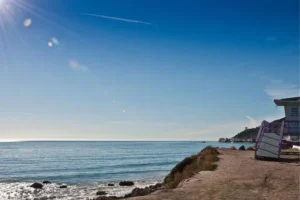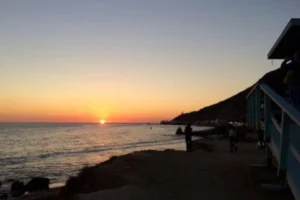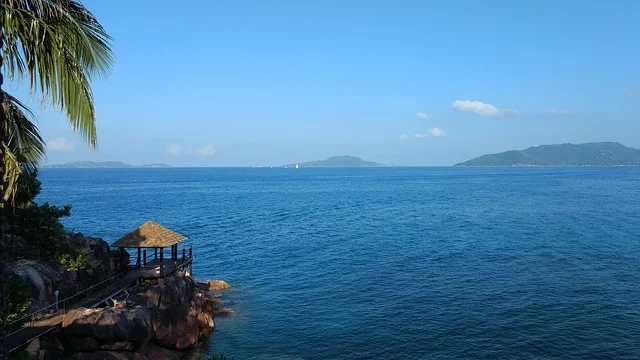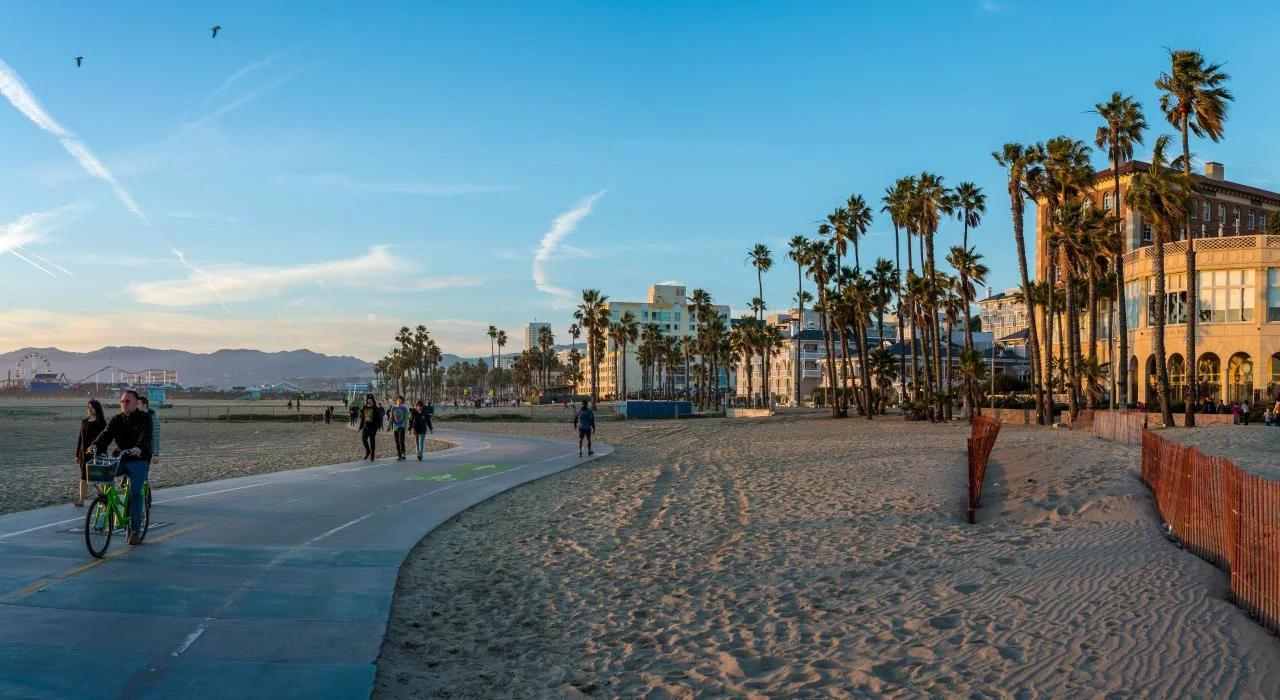Introduction:
When exploring the stunning coastline of Malibu, California, most visitors flock to the famous beaches like Zuma or El Matador. However, tucked away at the southern edge of this coastal paradise lies Las Tunas Beach – a hidden treasure that offers an authentic California beach experience without the crowds.
What Makes Las Tunas Beach Special?
Las Tunas Beach stands out as the southernmost beach in Malibu, offering visitors a unique blend of natural beauty and peaceful solitude. Unlike its more famous neighbors, this narrow stretch of coastline retains its wild, undeveloped character, making it feel like a secret local discovery.
The beach gets its name from the Spanish word “tunas,” referring to the fruit of the prickly pear cactus that once flourished in the nearby hills. This historical connection to the area’s natural heritage adds an extra layer of authenticity to your beach experience.
Location:
Las Tunas Beach Overview
| Feature | Details |
|---|---|
| Location | Southern Malibu, Los Angeles County |
| Beach Type | Rocky and sandy combination |
| Crowd Level | Low to moderate |
| Best For | Fishing, diving, surfing, and solitude |
| Parking | Street parking only |
| Facilities | Portable restrooms, lifeguard station |
| Pet Policy | Dogs are allowed on leash |
| Access | Steep path from street level |
Top Activities at Las Tunas Beach
Scuba Diving and Snorkeling
Las Tunas Beach has earned a reputation as one of the premier diving spots in the Malibu area. The rocky underwater terrain creates fascinating formations that attract both marine life and diving enthusiasts. The relatively calm conditions make it ideal for:
- Beginner divers taking their first ocean plunges
- Experienced divers exploring kelp forests
- Underwater photography enthusiasts are capturing marine life
- Dive training courses are conducted by local schools
Surf Fishing Excellence
The combination of rocky points and sandy areas creates perfect fishing conditions. Anglers regularly catch:
- Halibut and rockfish from the sandy areas
- Surf perch along the wave breaks
- Cabezon and lingcod near the rocky structures
- Occasional yellowtail during the summer months
Pro Fishing Tips:
- Early morning and evening offer the best bite times
- Rocky areas near the point produce larger fish
- Bring appropriate tackle for both sandy and rocky bottom fishing
- Check tide charts for optimal fishing conditions
Surfing the Hidden Breaks
While not as consistent as Malibu’s famous surf spots, Las Tunas Beach offers unique wave conditions that can surprise even experienced surfers. The rocky bottom creates distinctive wave formations that provide:
- Uncrowded sessions with minimal competition for waves
- Unique wave shapes formed by the rocky underwater terrain
- Consistently smaller waves are perfect for longboarding
- Advanced breaks during larger swells
Getting to Las Tunas Beach
Address and Directions
Las Tunas Beach is located along Pacific Coast Highway (PCH) in Malibu, California. The beach sits beneath the coastal bluffs, requiring a short but steep walk down to the water.
Driving Directions:
- Take Pacific Coast Highway to the Las Tunas Beach area.
- Look for limited street parking along PCH
- Find the beach access trail leading down from the road
- Navigate the somewhat steep path to reach the beach level
Parking Information
Parking at Las Tunas Beach requires patience and planning:
- Street parking is only along Pacific Coast Highway
- Limited spaces available, especially on weekends
- Free parking, but subject to street regulations
- Arrive early for the best parking opportunities
- Consider carpooling due to limited space
Beach Characteristics and Layout
Physical Features
Las Tunas Beach presents a unique coastal landscape that sets it apart from typical Southern California beaches:
Beach Composition:
- Mixed terrain of sandy patches and rocky outcroppings
- Narrow width that nearly disappears at high tide
- Dramatic bluffs rising directly behind the beach
- Tide pools are accessible during low tide periods
Seasonal Changes:
- Winter months bring larger waves and more dramatic conditions
- The summer season offers calmer waters, perfect for diving
- Spring and fall provide the most comfortable visiting conditions
- Tide variations significantly affect beach accessibility
What to Expect?
Las Tunas Beach offers a raw, authentic California coastal experience. Visitors should prepare for:
- Limited facilities compared to developed beaches
- Natural, undeveloped surroundings with minimal commercial influence
- Varying noise levels due to proximity to the Pacific Coast Highway
- Changing conditions based on tides and weather
Best Times to Visit Las Tunas Beach
Seasonal Considerations
Spring (March-May):
- Mild temperatures and fewer crowds
- Excellent diving visibility
- Wildflowers blooming on the bluffs
- Moderate surf conditions
Summer (June-August):
- Warmest water temperatures
- Calm conditions are ideal for swimming
- Peak diving season
- Increased weekend crowds
Fall (September-November):
- Best overall weather conditions
- Excellent surf fishing opportunities
- Comfortable temperatures
- Reduced tourist activity
Winter (December-February):
- Dramatic storm watching opportunities
- Challenging surf conditions
- Fewer visitors for maximum solitude
- Cooler water temperatures
Daily Timing Tips
Early Morning (Sunrise-9 AM):

- Best chance for solitude and parking
- Optimal fishing conditions
- Beautiful sunrise views over the ocean
- Calm conditions for diving
Midday (10 AM-3 PM):

- Warmest temperatures
- Good visibility for underwater activities
- The busiest period with the most visitors
- Parking becomes challenging
Evening (4 PM-Sunset):

- Spectacular sunset viewing
- Second peak for fishing activity
- Romantic atmosphere for couples
- Parking availability improves
Safety and Practical Information
Essential Safety Tips
- Check tide charts before visiting, as high tides can eliminate beach access
- Wear appropriate footwear for rocky terrain navigation
- Bring sun protection, as shade is limited
- Be aware of PCH traffic when parking and crossing the road
- Respect marine life in tide pools and diving areas
What to Bring?
For All Visitors:
- Water and snacks (no concessions available)
- Sunscreen and protective clothing
- Sturdy shoes for rocky areas
- Camera for capturing unique scenery
For Divers:
- Complete diving gear or rental arrangements
- Dive flag for safety
- Buddy system partnerships
- Emergency contact information
For Anglers:
- Fishing license (required for all ocean fishing)
- Appropriate tackle for mixed terrain
- Bait and equipment for surf fishing
- Cooler for catch storage
Environmental Responsibility
Las Tunas Beach remains pristine because visitors respect its natural environment. Help preserve this hidden gem by:
- Packing out all trash and leaving no trace
- Respecting wildlife and maintaining safe distances
- Staying on designated paths to prevent erosion
- Following fishing regulations and size limits
- Protecting tide pool ecosystems during exploration
Historical Significance
Las Tunas Beach carries fascinating stories from California’s coastal past. In 1926, a massive winter storm demonstrated the raw power of the Pacific Ocean by washing twenty houses completely off the beach. This dramatic event serves as a reminder of nature’s ultimate authority over coastal development.
The area’s name connects to the indigenous plants that once dominated the landscape. The prickly pear cactus, whose fruit locals called “tunas,” created the Spanish name that endures today.
Local Insider Tips
Secret Spots:
- The northern rocky point offers the best fishing during incoming tides
- Low tide reveals hidden tide pools perfect for exploration
- Early morning visits provide the best wildlife viewing opportunities
Photography Opportunities:
- Sunrise shots from the eastern-facing beach capture dramatic lighting
- Rocky formations create interesting foreground elements
- Macro photography in tide pools reveals incredible detail
Weather Considerations:
- The marine layer often clears by late morning
- Afternoon winds can create challenging conditions
- Winter storms provide dramatic (but potentially dangerous) scenery
Frequently Asked Questions About Las Tunas Beach
Q1. Is Las Tunas Beach free to visit?
Yes, Las Tunas Beach is completely free to visit. There are no entrance fees or parking charges. However, parking is limited to street parking along Pacific Coast Highway, which can be competitive during peak times. The beach is operated by Los Angeles County and maintained as a public beach accessible to everyone.
Q2. Are there restrooms and facilities at Las Tunas Beach?
Las Tunas Beach has minimal facilities compared to developed beaches. You’ll find portable restrooms available, and there’s a lifeguard station positioned above the beach. However, there are no concession stands, showers, or equipment rentals. Visitors should bring their water, snacks, and any beach equipment they need.
Q3. Can I bring my dog to Las Tunas Beach?
Yes, dogs are welcome at Las Tunas Beach, but they must be kept on a leash at all times. This is a Los Angeles County regulation for all county beaches. Make sure to clean up after your pet and bring water for them, as the beach has no facilities for pets. The rocky terrain can be challenging for some dogs, so consider your pet’s mobility and comfort.
Q4. What’s the best time to visit Las Tunas Beach for parking?
The best time to find parking is early morning (before 9 AM) or late afternoon (after 4 PM). Weekdays are generally less crowded than weekends. Summer months and holidays see the highest traffic, so plan accordingly. If you arrive and don’t find parking immediately, try driving a bit further along PCH as additional spots may be available.
Q5. Is Las Tunas Beach safe for swimming and diving?
Las Tunas Beach can be safe for swimming and diving when conditions are appropriate, but visitors should exercise caution. The beach has a lifeguard station, but conditions can change rapidly. The rocky bottom and narrow beach mean high tides can create challenging conditions. Always check current weather and surf reports, swim near the lifeguard station when possible, and never dive alone.
Q6. How difficult is the walk down to Las Tunas Beach?
The walk down to Las Tunas Beach involves a moderately steep path from street level. Most visitors can handle the descent, but it may be challenging for those with mobility issues or when carrying heavy equipment like diving gear. The path is not paved and can be slippery when wet. Wear appropriate footwear and take your time, especially when carrying gear back up to your car.
Conclusion: Your Hidden Beach Adventure Awaits
Las Tunas Beach represents everything that makes California’s coastline special – natural beauty, diverse activities, and the promise of discovery. While it may not offer the amenities of developed beaches, it provides something increasingly rare: an authentic connection to the ocean in its natural state.
Whether you’re an experienced diver seeking new underwater adventures, an angler looking for productive fishing spots, or simply someone who appreciates the raw beauty of California’s coast, Las Tunas Beach offers an experience that feels genuinely special. The combination of dramatic scenery, diverse activities, and peaceful solitude creates memories that last long after you’ve climbed back up the bluff to your car.
Remember that the best beaches often require a little effort to reach and appreciate. Las Tunas Beach rewards those who seek it out with an experience that captures the true spirit of California’s magnificent coastline. Pack your sense of adventure, respect for nature, and appreciation for hidden treasures – Las Tunas Beach is waiting to share its secrets with you.


